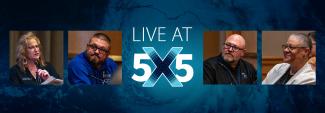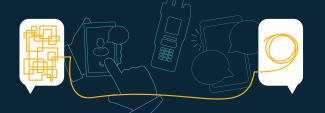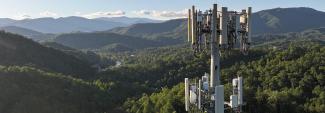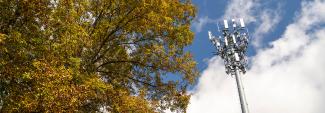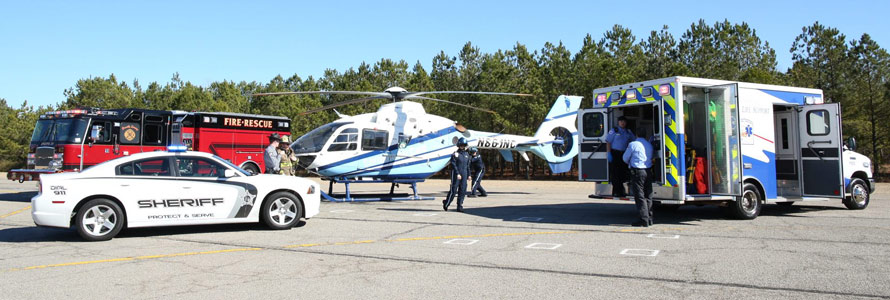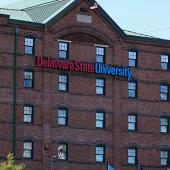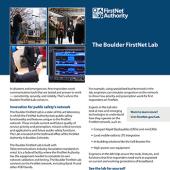Summary
Guest
Kyle Richardson
FirstNet Senior Public Safety Advisor, Region VII (IA, KS, MO, NE and OH)
T.J. Martin
Radio Communications Coordinator/ Public Information Officer, City of Parma, Ohio - Fire Department
Transcript
Preview
Narrator: You’re listening to Public Safety First, a podcast to help you learn about the First Responder Network Authority and how you can be part of the future of public safety technology.
And now your host.
Kyle Richardson: Good afternoon. Welcome to the Public Safety First podcast. I’m Kyle Richardson, and I serve as a Senior Public Safety Advisor in the North Central Region. I cover states Missouri, Kansas, Iowa, Nebraska, and Ohio, and I’m here in Parma, Ohio, today speaking with T.J. Martin of the Parma Fire Department.
T.J., how are you doing? Welcome to the podcast.
T.J. Martin: I’m well, how are you?
Kyle Richardson: Great, great. So you guys, tell me a little about Parma, for somebody that’s not from here.
Narrator: You’re listening to Public Safety First, a podcast to help you learn about the First Responder Network Authority and how you can be part of the future of public safety technology.
And now your host.
Kyle Richardson: Good afternoon. Welcome to the Public Safety First podcast. I’m Kyle Richardson, and I serve as a Senior Public Safety Advisor in the North Central Region. I cover states Missouri, Kansas, Iowa, Nebraska, and Ohio, and I’m here in Parma, Ohio, today speaking with T.J. Martin of the Parma Fire Department.
T.J., how are you doing? Welcome to the podcast.
T.J. Martin: I’m well, how are you?
Kyle Richardson: Great, great. So you guys, tell me a little about Parma, for somebody that’s not from here.
T.J. Martin: Parma is the seventh largest city in the State of Ohio. We currently staff five fire stations, providing both fire and EMS for a community of about 80-85,000 people. As I said, we are the seventh largest city in the state of Ohio. We also are very active in both hazmat, confined space, any kind of emergency operations imaginable, we handle through the fire department.
Kyle Richardson: Great, and how long have you been a firefighter?
T.J. Martin: 30 years now.
Kyle Richardson: Wow.
T.J. Martin: 30 years.
Kyle Richardson: So, you guys would be considered a suburb of Cleveland?
T.J. Martin: Cleveland, correct.
Kyle Richardson: You have some work together with Cleveland?
T.J. Martin: We do, not too often. We have some borders that we share with them. But we try to handle our own and they try to handle their own, so the tide doesn’t often meet.
Kyle Richardson: No doubt. So you’ve been using FirstNet since when?
T.J. Martin: Actually, we just started. I just started myself. I’ve been in on the hopeful planning, making revolutions for our department to have FirstNet subsidize our backbone. And then I just recently went on my own personal with a black SIM card to get on the FirstNet system, so, and I find it invaluable.
Kyle Richardson: Great, yeah. Expand upon that a little bit, you’ve been using it for a little bit here – what are the kind of things that you find invaluable about it?
T.J. Martin: I have connectivity anywhere. Parma, being one of the, well probably one of the largest communities in Cuyahoga County, we also sit at the highest point in Cuyahoga County. So, we’re kind of covered with cell phone coverage on the commercial network pretty well. Our problem is the handoff. So when we go from one site to the other, inevitably we drop calls, which is a problem with every carrier. I’ve found that that potential and that occurrence is significantly less – and maybe it’s only perceived – but I find it significantly less on the Band 14 FirstNet card. Whereas, I don’t lose connectivity as much as I used to.
Kyle Richardson: Absolutely, so what are some of the benefits that you see beyond what a commercial offering is, for example?
T.J. Martin: I think that once as it develops and as we develop more programs or more apps are developed, EPTT – or the enhanced push-to-talk – is going to be a lifesaver. It’s not only going to be a valuable asset, it’s going to be literally a lifesaver.
I think that some of the innovations – and again, let’s preface this back that when FirstNet first appeared, I became very interested, and as I said before, I’m not one of the high school, you know, AV guys. I was not of that ilk, but with a dad that was a fire chief and a dad that was an electrician, I got into electronics, and my actual full title on the fire department is Communications Coordinator. I run the computer systems, and then I also am the Public Information Officer, so I have a broad range of spectrum of things that I handle. And it’s kind of put me into contact with a lot of different applications and services that are available out there.
When FirstNet first came out, I was a little skeptical at first, and then after reading some of the research and some of the background, I just literally fell in love with it because I know that the potential is there. I think that it’s going to, in the future, some of the things that we have talked about and some of the articles that I’ve seen between the biometrics that they’re going to have built into a lot of our personal equipment, that where you can use the eight, you can still use your LMRs [land mobile radios] and use the FirstNet as part of the data transmission for that back to a command and control situation where they can monitor somebody that’s inside of a fire that they can’t physically see.
And then you couple those in with other things like telecommunications. Part of our plan is to equip all of our vehicles at some time in the future, with, to make them in essence, mobile cell towers through the AT&T FirstNet program, where we put it, we can get mission-critical information through anyplace we’re at by simply installing a simple cell router with an AT&T black SIM card and mission-critical information is at your fingertips. With a greater baud rate and a greater download speed than we’ve ever seen in anything else.
Kyle Richardson: That’s great. And you know, my background is a Public Information Officer, so I found that interesting about you and you got the communication stuff too, so those worlds are colliding right there.
T.J. Martin: They are, they are. Sometimes too much, but they collide. And it’s kind of fun to do that, because you can see both sides of everything. So as I said, I’ve been around on the fire service for years where, you know, each vehicle had one radio, and we were on a low band system that we would get skip trace, or skip from Canada, where every once in a while we would hear Canada transmissions to now having fully encrypted 800 megahertz systems, and now we’re adding another spectrum into that with the Band 14 on the AT&T FirstNet system.
Kyle Richardson: So with being a PIO, there’s some applicability there as well, too, right, where you are, the ability to be able to stream high speed data, push it out to the public, so you got the piece of informing the public –
T.J. Martin: Right.
Kyle Richardson: – ahead, during, after, and also the work with as an interface to the media as well.
T.J. Martin: Correct. And that’s one of the big things, because I’ve been at several fires in the past where the media knows about it because they’re monitoring the radio transmissions. They’re calling you constantly asking you for updates. And it will be so simple to just have a device where you can do a terse, immediate press release that all the media would have their questions answered and then further information can be forthcoming. Part of my duties is to update our social networking sites, too, and our public really just loves the opportunity to be able to see a fire live. When you show up and you can picture, take a video and push it out live through Facebook – that gets so many more hits than just a static publication through Facebook.
And one of the things that we’re doing in this community, and I know a lot of other communities across the country are doing it, is the Code Red to notify your community of natural emergencies. The capabilities that are going to be afforded to public entities, to emergency operations entities, is to update – to the minute – your community on hazardous situations, no matter what your current situation may be. So, everybody hopes that their LMR keeps, and their integrity of their own system is not compromised at any one point in time, but the potential is still there. With the FirstNet, that kind of is a back-up to your LMR, where you could push that information out at a seconds’ notice and people have mission-critical information to their own personal lives as we’re getting the mission-critical information on the scene.
Kyle Richardson: That’s great. So we talked ahead of time about, so FirstNet is going to continue to innovate for the future, we have to. It’s a 25-year contract with AT&T, there’s a five – we’re in year two of a five-year build-out. We also are prioritizing with public safety, with you, to truly make it your network, and to look ahead to the feature sets that you really want to make it a customized network, right?
So we went over five areas, which have been laid out in our initial plan for the Roadmap, so as we collaborate to, as we collaborate to refine it, the five areas being coverage and capacity, situational awareness, voice communications, secure information exchange, and user experience, what would you say, for you, is number one out of those five?
T.J. Martin: Probably the coverage. That’s going to be a big factor. Everybody can show you a map of where their cell towers are. That doesn’t mean anything when you’re in the middle of the desert and you can’t get anything, where things do happen. Obviously each individual geographic area throughout the country has their own intrinsic things that prevent them from getting a cell signal.
Kyle Richardson: I was going to say, do you have deserts out here?
T.J. Martin: No, but we have big buildings. You have internal buildings where you go in and they’re built like bomb shelters, so, you know, LMRs don’t work in there, cell signal wouldn’t work, even less. So to get those built out would be, in my estimation, a primary priority, because if it doesn’t work, they’re not going to use it. So that build-out is going to be integral to getting this to fly everywhere. It’s no problem when you have great coverage, but when you don’t, then it becomes ‘I’m not going to use this.’
Kyle Richardson: So you’ve had great coverage, or at least you’ve had good coverage, right –
T.J. Martin: Right.
Kyle Richardson: – what are some of the unique features that you’re looking forward to coming down the line? We touched on them a little bit – anything that comes to mind?
T.J. Martin: I really think that the biometrics for police and firefighters in the field, where they can be monitored, even at a remote control location, say the EOC [emergency operations center], or the dispatch center, where they can be monitored. How many police officers or firefighters perished because they were in a situation where they didn’t realize their blood pressure had spiked, and, you know, their heart rate had spiked.
The hardest part of our job is, not necessarily putting out the fire, it’s communicating at a fire. So if we can provide something that improves communication, provides on-scene mission-critical information, that’s going to be one of the biggest landslides, in my estimation, to improve this entire system. And I think that we’re working towards that end, and once we can bring that out to the individual departments, the people that have not changed in 30 years, where we can show them this innovation, you know, we, unfortunately we still have people that are using VCRs. So, if we can show people you don’t need to use a VCR, you can do everything through an mp4, or you can download this, or, you know, this available in another avenue, if we can show them that and show them there is a better way, you’re golden. The system will take off. It’ll actually perpetuate itself.
Kyle Richardson: How key is it for you – public safety – to work with the vendor community as they develop solutions?
T.J. Martin: That’s the only way they’re going to get to know how to do things. I can sell you something, and tell you it’s the greatest, but until you use it, until you’re driving down the street at three o’clock in the morning, and getting bounced around on the back of a fire truck, or getting bounced around in the back of an ambulance, or you’re in an environment where the temperature is barely bearable where you can feel your ears burning, you don’t know if it works or not. You can tell me it does, but I don’t know it does.
So, there’s a big – and that’s one of the vendors that we did work with that were very magnanimous and helpful in this, and they were the first ones to approach us and they actually had provided us with a mobile cell router, and we put it in one of our ambulances to improve our prehospital communications with a physician and telemedicine, and it has offered a substantial – I cannot actually explain it how much it has provided for prehospital communications through, not only voice, but video. When you can bring the doctor to the house, it’s like the old days of making house calls. Where we’re bringing the emergency physician to the home through a cell network. The possibilities after that are endless.
Kyle Richardson: So we talked about the push-to-talk interconnection. When can you envision your organization, Parma Fire, incorporating PTT over LTE?
T.J. Martin: Actually we’re in the process of doing that as we speak. All of our current radio equipment that we’re purchasing will be not only C1 D1 compliant for our specifications, but will have LTE intrinsic into them. So once I get enough of those out into the field, we can start implementing the emergency PTT in all of those in addition to our LMRs.
Right now, as well, we’re working with our command staff to get them all up on the FirstNet system as well. Again, sometimes people are a little bit reticent to change, and, you know, some of us do it on our own, and then some of them they have to wait to be told do it. But we’re working with our command staff now to get them on the same system so that they can realize the benefits that, you know, the rest of the country is realizing.
Kyle Richardson: So how do you anticipate putting that into your operations? You have any, like, real use cases, ranging from ‘not at all’ to ‘getting close to almost a replacement for your land mobile radio down the line’?
T.J. Martin: I think the replacement – full replacement – of a land mobile radio will be very difficult. Parma owns its own system, so we have our own radio communications system, 800 megahertz system that’s ours, that we own. Obviously we’d like more capabilities with it. Which, as I’ve said before, that FirstNet will not only enhance the back-up, it’s going to provide a greater coverage area, in my estimation, to our LMRs.
And again, that’s the heartbeat of interoperability that was thought about so many years ago. They want to be able to have people that are from Parma be able to get called at a major incident to Columbus, or even, let’s take it to even a smaller town, a little, you know, 800-person town that needs the help, where we’d have interoperability with them without having to grab one of their radios, or try to have them find enough radios for everybody that’s coming in to work.
One of the things back in 9/11, twelve members of the City of Parma Fire Department went to New York to help bail out. And one of the biggest factors that we had at that time, which obviously was part of the impetus for interoperability, was we weren’t able to talk to anybody. It was all word of mouth. And the chaotic scene that was after 9/11 made even talking to one another extremely difficult. There was a neighboring department that had sent some firefighters as well, and they actually, we were supposed to help them operate at a burning building, and we couldn’t find out where they were because there was no communication. Imagine if FirstNet were around back then. It would have been a simple process to find out where they were. And even to the extent of, you know, geolocation of certain devices on an area you’re not familiar with. It’s all there.
Kyle Richardson: Well, T.J., it’s been a pleasure to meet you, and I’m looking forward to continuing this partnership.
T.J. Martin: Likewise, and the pleasure was all ours. We appreciate it very much.
Kyle Richardson: All right.
Narrator: Thanks for listening today. We're excited to have you join our podcast community. Make sure to subscribe on iTunes, SoundCloud, and YouTube. You can learn more about the First Responder Network Authority at FirstNet.gov and learn about FirstNet products and services at FirstNet.com.



